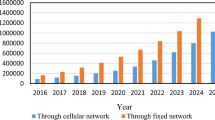Abstract
Improved spectral and energy efficiency are two key requirements for the next generation (5G) wireless communication systems. The inefficiency and non-linearity of traditional power amplifiers (PA) pose significant challenges to meet these requirements, especially for multicarrier modulation signals with high peak to average power ratio (PAPR). Orthogonal frequency division multiplexing (OFDM) is currently the most widely used multi carrier modulation technique; it has been adopted in many wireless communication standards including IEEE 802.11, 802.16, 3GPP Long Term Evolution and WiMAX. When a high PAPR signal process through a nonlinear power amplifier (PA), intermodulation distortion is generated, creating out-of-band emission that can interfere with other transmission in adjacent bands. In addition, in-band distortion, which degrades the bit error rate performance, occurs. Hence, I have addressed these problems by employing four different PAPR reduction techniques such as Phase modulation, Rail clipping, Sample and Hold approach and Threshold methods based on amplitude clipping. For practical proof of the proposed concepts, I have chosen software defined radio as an experimental setup that employs USRP N210 as hardware and GNU Radio as software.
















Similar content being viewed by others
References
Ochiai, H., & Imai, H. (2001). On the distribution of the peak-to-average power ratio in OFDM signals. IEEE Transactions on Communications, 49(2), 282–289.
Siva Kumar Reddy, B., & Lakshmi, B. (2013). Channel coding and clipping in OFDM for WiMAX using SDR. ACEEE-International Journal on Recent trends in Engineering and Technology, 9, 1–12.
Jiang, T., Guizani, M., Chen, H.-H., Xiang, W., & Wu, Y. (2008). Derivation of PAPR distribution for OFDM wireless systems based on extreme value theory. IEEE Transactions on Wireless Communications, 7(3), 1298–1305.
Mitola, J. (1992). Software radios-survey, critical evaluation and future directions. IEEE National Telesystems Conference, 13/15—-13/23, 19–20.
Texas Instruments (2012). Software Defined Radio, http://www.ti.com/solution/software-defined-radio-sdr-diagram.
Harris, F., Lowdermilk, W.. (2010). Software Defined Radio. Part 22 in a Series of Tutorials on Instrumentation and Measurement.
Ettus Research, USRP N210 (2012). https://www.ettus.com/product/details/UN210-KIT. Accessed 08 February 2014.
GNU Radio (2012). The GNU Radio Companion. http://www.ece.uvic.ca/~elec350/grc_doc/ar01s01.html.
Thompson, Steven C., Proakis, John G., Zeidler, & James R. (2005). Noncoherent reception of constant envelope OFDM in flat fading channels, IEEE 16th International Symposium on Personal,Indoor and Mobile Radio Communications, PIMRC 2005, 1.
Thompson, Steve C., et al. (2008). Constant envelope OFDM. IEEE Transactions on Communications, 56(8), 1300–1312.
Siva Kumar Reddy, B., & Lakshmi, B. (2015). Minimizing PAPR and Synchronization Errors in OFDM for WiMAX Using Software Defined Radio. Journal of Circuits, Systems and Computers, 24(4), 13–26.
Proakis, J. G. (2001). Digital communications (4th ed.). New York: McGrawHill.
Simon, M. K., & Alouini, M.-S. (2000). Digital communication over fading channels. New York: John Wiley & Sons Inc.
Patzold, M. (2002). Mobile fading channels. West Sussex, England: John Wiley & Sons.
Author information
Authors and Affiliations
Corresponding author
Rights and permissions
About this article
Cite this article
Reddy, B.S.K. Performance Improvement Techniques for OFDM system using Software Defined Radio. Wireless Pers Commun 91, 1065–1083 (2016). https://doi.org/10.1007/s11277-016-3512-5
Published:
Issue Date:
DOI: https://doi.org/10.1007/s11277-016-3512-5




